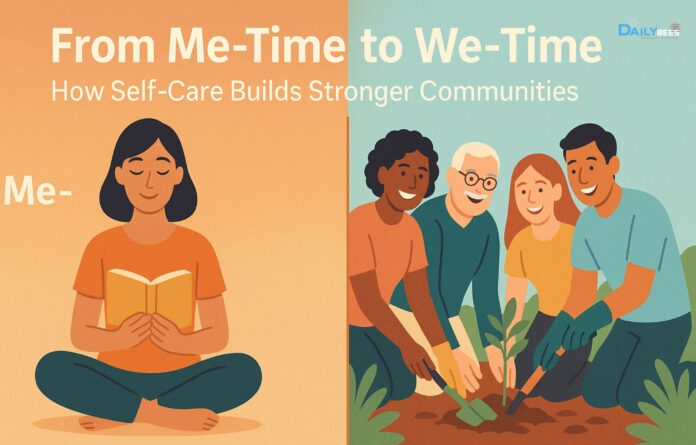In our busy modern lives, self-care has become a buzzword. Self-care goes far beyond pampering routines or trendy health drinks—it’s a conscious effort to nurture your mental, physical, and emotional well-being. More importantly, it’s the foundation for building stronger, more connected communities.
Yes, it starts with you—but it doesn’t end there.
Let’s explore how self-care and community go hand in hand. How your personal wellness can spark a ripple effect that uplifts everyone around you. And how together, we can move from “me-time” to “we-time,” creating a culture of wellness for all.
Table of Contents
Why Self-Care Matters Now More Than Ever
We live in a world that never stops. Constant notifications. Long workdays. Overloaded schedules. It’s easy to put yourself last.
But here’s the truth: You can’t pour from an empty cup.
Self-care is the act of filling your cup—physically, emotionally, mentally. When you feel whole, grounded, and rested, you show up better. For your family. For your job. For your community.
When neglected, stress takes over. Burnout follows. Relationships suffer. Health declines.
That’s why practicing stress management techniques is not optional—it’s necessary.
Examples of Easy Self-Care Practices:
- A 10-minute walk in the fresh air
- Stretching before bed
- Journaling your thoughts
- Saying “no” without guilt
- Talking to a friend when you feel overwhelmed
- Taking deep breaths when stress kicks in
Small actions. Big impact.
If you’re looking for a winter grooming routine, check out this helpful guide on beard care during winters for tips to stay comfortable and well-groomed throughout the colder months.
The Link Between Self-Care and Community
You may think self-care is a solo mission. But that’s only half the story.
When you prioritize your well-being, your behavior shifts. You become calmer, more patient, more understanding. You’re not running on fumes. You listen better – smile more – and radiate peace.
Others notice.
And without even realizing it, your self-care inspires those around you. A friend starts going to therapy. Your colleague takes mental health days. Your neighbor begins daily walks.
One person’s wellness encourages another’s.
This is the beautiful bridge between self-care and community. We rise together.
Wellness for All: Making Self-Care Inclusive
Let’s talk about wellness for all. Because true well-being isn’t just for those with time or money.
Community wellness starts with access—making sure everyone has the opportunity to take care of themselves, regardless of background or income.
That means:
- Safe parks to walk or play
- Affordable therapy or mental health support
- Free or low-cost wellness events
- Culturally inclusive health education
- Employers who respect work-life balance
When self-care becomes a shared value—something we all support and uplift—then we begin to build a culture of collective well-being.
From Isolation to Connection: The Social Side of Self-Care
Self-care can also be deeply social. Think about the last time you joined a group yoga session, a walking club, or even a community clean-up.
It felt good, right?
These shared acts of care create bonds. They reduce loneliness. They replace scrolling with conversations. Complaints with compassion.
Loneliness is a rising issue worldwide, and one of the best antidotes is connection. Not just digital ones, but real, heart-to-heart human contact.
By prioritizing both individual wellness and community engagement, we tackle loneliness and foster belonging.
Raising Self-Care Awareness
So how do we encourage more people to value self-care?
Self-care awareness begins with conversation. It involves creating space in everyday life to slow down, recover, and check in with yourself.
Want to inspire others? Here are some simple ways to promote self-care in your community:
- Share your self-care routine on social media
- Host a wellness chat or event
- Talk openly about stress and how you manage it
- Encourage loved ones to take time for themselves
- Support friends who set healthy boundaries
The more we speak up, the more permission others feel to do the same.
The Ripple Effect of Stress Management
Stress doesn’t stay in a box. When one person in a family or team is stressed, it affects everyone.
But here’s the good news: calm spreads too.
By using stress management techniques, you not only improve your life—you change the atmosphere around you.
Try this:
- Next time you’re feeling overwhelmed, pause and breathe deeply for 30 seconds.
- When someone upsets you, respond with patience instead of reacting in anger.
- Create a peaceful morning routine to carry good energy into your day.
These simple habits model emotional intelligence, self-awareness, and resilience. Others will notice. Some will follow.
And slowly, stress loses its grip—not just on you, but on your whole community.
Need more ideas? Explore these expert-backed tips to reduce stress from the NHS for practical, science-based techniques you can try right away.
The “We-Time” Movement: Building Communities That Care
Imagine a world where everyone practiced self-care. Where every person took time to breathe, reflect, and show up with kindness.
Now imagine that world expanding into neighborhoods, workplaces, and schools.
- Children learning about mindfulness in classrooms
- Coworkers taking group stretch breaks
- Families cooking healthy meals together
- Local groups hosting walk-and-talk wellness meetups
This is what it means to turn “me-time” into “we-time.”
It’s a movement. A mindset. A mission to build better, more compassionate communities—one self-caring individual at a time.
Final Thoughts: Small Acts, Big Change
We often underestimate the power of small actions.
But here’s the truth: Every time you choose to care for yourself, you create space. Space for empathy. Space for support. Space for connection.
Self-care is not a detour from community—it’s the doorway into it.
As the iconic film Anand reminds us, “Zindagi badi honi chahiye, lambi nahi.” What truly matters is the depth and richness of life—not just the number of years we live.
And what makes life truly meaningful? Purpose. Connection. And caring for both yourself and others.
So take your walk. Eat your veggies. Rest when you’re tired. Laugh often. Say “no” when needed. Meditate. Journal. Talk it out.
Because when you do, you’re not just healing yourself—you’re strengthening the heart of your community.
Let’s embrace the shift from me-time to we-time. Because in the end, collective well-being begins with you.













